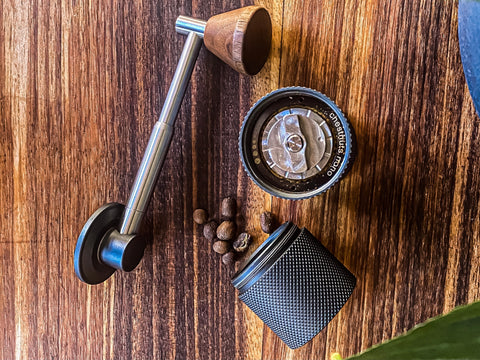
Is mediocre coffee not for you? Are you trying to prepare the perfect cup? If so, using freshly ground coffee beans is a must. Most coffee nerds would argue that grinding your beans immediately before brewing is the first rule for making good coffee. If you ever smell freshly ground coffee, or enjoy a cup made from a fresh grind, you’ll soon notice that bags of pre-ground coffee smell… rather stale. This isn’t necessarily because the coffee has outright expired, or even because it’s been all that long since it was ground (though many supermarkets sell coffee that was ground several months prior, as an unpleasant necessity of mass distribution). The truth is, coffee technically lasts a rather long time, even once it’s been ground. That said, once coffee has been ground it begins to lose its unique and desirable properties almost immediately. Even if coffee made with beans that were ground a few weeks prior is technically fit for human consumption, it probably won’t taste very good. Additionally, grinding your beans before brewing isn’t just important for quality; it can also be a very pleasant part of the ritual of making coffee every morning.
Why you should care about your grinder
There’s a bit more to the story than just the idea that freshly ground beans are better. How those beans are ground is one of the most important factors in determining the quality of the final cup. If you are looking to improve the coffee you make at home, buying a better coffee grinder is perhaps the single best investment you can make. As coffee nerds, we can be prone to hyperbole, but there really is no overstating this: no matter how expensive your brewing equipment, it will never compensate for stale or poorly ground coffee.
In this article we’ll be going over the basic theory of coffee grinders, why some are simply a cut above the rest and how to find the right grinder for you.
Blade grinders and burr grinders

Image by Dan Smedley on Unsplash
All brew methods make coffee using the same basic process: hot water is passed through particles of ground coffee. A huge factor in determining the qualities of the final cup is how many oils and compounds are extracted from each of those grounds into the hot water. How much or how little should be extracted depends on individual tastes, the specific coffee being brewed, and the brew method being used. A good way to influence extraction in either direction is through adjusting the size of your coffee grounds, which blade grinders can’t do in the first place. Regardless, it is generally agreed that extreme under-extraction or over-extraction leads to unpleasant flavours. What can create an even less pleasant drinking experience, though, is an uneven extraction, and this is where the idea of grind uniformity comes into play. If the coffee grounds being brewed are of an inconsistent size - some far smaller or far larger than others - what happens is a combination of over-extraction from some grounds and under-extraction from others. What results is a cup of coffee with no clear character and an array of unpleasant tasting notes.
So what does this have to do with your grinder? There are two basic types of coffee grinder: blade grinders and burr grinders. If you’ve ever bought a suspiciously cheap electric grinder, the odds are it’s a blade grinder. These don’t grind coffee in the literal sense. They work by smashing coffee beans into pieces using a rapidly rotating pair of blades. They are cheap and easy to manufacture, and therefore ubiquitous, but their complete lack of consistency makes for poor quality coffee. In short: because a blade grinder inherently cannot output a consistent grind, using one guarantees an uneven extraction and a less pleasant cup of coffee. If you buy specialty coffee, few if any of the interesting qualities you are paying for will make it into your cup after the coffee is subjected to a blade grinder. Considering the care that farmers and roasters put into their offerings, this is rather sad! Thus, we can only endorse blade grinders if your budget makes them the absolute only option - as they can come in at around half of the cost of the most affordable grinders we will be recommending. Even then, it may be worth simply biding your time until you can get your hands on an entry-level burr grinder that suits your needs.
So, why a burr grinder? By virtue of how they work, burr grinders overcome every issue a blade grinder presents. In contrast to the chopping motion of a blade grinder, a burr grinder crushes the coffee bean between a pair of metal or ceramic burrs, which ensures a far better end result. The distance between the burrs is usually adjustable, allowing the grind to be made more fine or more coarse. The grounds can only leave the grinder mechanism once they are below the required size, ensuring a certain degree of consistency. The result? Burr grinders significantly reduce the degree of particle size distribution, and the user can influence the degree of extraction they desire in their cup by modifying the size of the grounds they’re brewing with.
At least, that’s the idea. Burr grinders still come in many shapes and sizes, and vary dramatically in how well they fulfil their role. If you’re looking to take the plunge and ditch your blade grinder, finding the right option for you can still be overwhelming. There are plenty of options to choose from!
What to look for in a grinder

Image via Crew on Unsplash
The most obvious consideration is your budget, and which grinder will provide you with the best value for money. It’s here that it’s worth understanding that not all burr sets are created equal. As a rule of thumb, higher end burr grinders will achieve a higher degree of consistency. There’s some debate as to whether, at the extreme high end of coffee grinders, perfect consistency is even desirable. Within the scope of this article, we’ll assume that more consistency is always desirable.
Still, this may be an oversimplification. The consistency of different grinders isn’t linear, per se; it can actually begin to vary as you change the grind size you’re aiming for. Some will grind on a coarse setting wonderfully consistently, but struggle as soon as you attempt a finer setting, and vice versa. Consider this in tandem with another fact: different brew methods vary dramatically in what grind size provides desirable results. For espresso, you need to grind extremely finely, far more so than you do if you’re using a French press. The coffee made with a French press will begin to taste worse if your grind is too fine. Thus, the considerations here are a lot more complex than they may seem. A high-end espresso grinder may be sold at a far higher price than a capable grinder meant for manual brew methods, and provide far worse results if you’re trying to use it with your trusty V60.
Aside from consistency, there are many more considerations to make that relate to your specific needs. Are you willing to pay more for the convenience of an electric grind? Do you actively prefer the experience of grinding your coffee by hand in the morning? Is portability a benefit? How much space can you afford to dedicate to your coffee setup?
To deal with the complexity of this equation, we’ve separated our recommendations into several categories considering both budget and intended use.
Absolute budget grinders for manual brew methods
Even at the absolute entry level, you can still get a solid burr grinder capable of grinding coffee which is consistent and suitable for manual brew methods such as a French press, AeroPress or pour-over. The Hario range of hand grinders is the natural recommendation in this category. The original Skerton defined the entry-level space here for years, and today Hario manufactures several revised versions of the iconic product.

Today, the most popular variant is the Hario Mini-Slim Plus, at least at Cape Coffee Beans. Small, portable and durable, the Mini-Slim Plus is an obvious choice if you’re looking for a grinder you can easily throw in your travel bag alongside an AeroPress. The trade-off you make for this portability comes in the form of the Mini-Slim’s low capacity. It can only grind around 24g of coffee at a time, which is only enough for one large cup. If you’re looking to grind enough coffee for more than one person, it may be worth opting for its larger sibling, the Skerton Plus, which can handle up to 100g of coffee at a time and features a more premium, glass construction.
Both of the burr sets in these grinders are “stepped”. You can adjust the size of the grind by arbitrary amounts (called “steps”) using a mechanism found inside the grinder. This works well for manual brew methods which do not require the same degree of precise calibration as espresso, and any given grind setting you find works well can easily be repeated in future if you note down how you had the burrs configured. Personally, I keep a notebook with the different grind settings I’ve found work best for each coffee I’ve tried in my AeroPress.
The downside of these more affordable grinders is that the burrs they use are made from a cheaper ceramic. More premium grinders will often use steel burrs, which can grind more coffee faster, or simply be far larger. This can make a big difference when you’re turning the grinder by hand! Either way, the Hario grinders are still a solid choice, and many coffee enthusiasts keep a spare one in the cupboard to use when travelling — or as a redundant grinder when loadshedding disables the rest of their setup.
We’d consider:
The best value grinders for manual brew methods
If you’re looking to spend a little more on a hand grinder, you’ll certainly be rewarded. Recently, there are more and more options in what used to be a “missing middle” price range. Consumers are increasingly able to purchase grinders that offer a more premium experience than the entry-level Skerton without quite entering the ultra-high end realm of hand grinders.
We often recommend the Timemore Chestnut C at this price range. A durable and portable grinder, the Chestnut C exemplifies this emerging category of hand grinders, most noticeably through its attractive modern design and use of premium-feeling materials. It features replaceable steel burrs, which are preferable to ceramic burrs in a hand turned grinder, as they can grind a given quantity of coffee faster and save you from fatigue. While a stepless grinder — which would allow you to adjust the grind size to near infinite precision — might be better for espresso, the Chestnut still features stepped burrs. This isn’t a huge issue, especially when you’ll still be looking to spend a fair bit more if you want a grinder that’ll truly serve you well for regular espresso-making. The C range’s adjustment mechanism comes in the form of a handy, clicky dial that provides satisfying tactile feedback and allows you to easily repeat recipes for successful brews by noting down how many “clicks” you had the grinder set to.
It’s difficult to recommend anything except the Chestnut C in this category, because at the time of writing it offers unbeatable value in its price range. The two nearest competitors, Mylo Coffee Company's SG 1 and the 1Zpresso Q2 will offer more quality of life improvements and marginally better performance, but at a relative cost that may be less accessible to some buyers. Currently, the Chestnut C2 remains our recommendation in this category while it’s available. In future, we reckon the Timemore Chestnut series of grinders will continue to comfortably serve this corner of the market.
We’d consider:
Electric grinders for manual brew methods
If you’re looking to avoid the morning workout that grinding coffee beans by hand entails, you may want to consider an electric grinder. There are two options on the lower end of price that we’ve been delighted to discover perform wonderfully well for manual brew methods: the Dualit Conical Burr Grinder Grinder and the Timemore x Millab E01. Both of these grinders feature conical steel burrs, and offer different approaches to an electric grinder intended for manual brew methods. Which you prefer will depend on your use case.
The Dualit, which is attractively affordable, performs impressively for an electric grinder in this price range. Its feature set makes for a very convenient experience: the hopper has a capacity of 250g, meaning it can hold adequate stock of beans. It can be configured to stop grinding after various set amounts of time (based on a numbered dial), or toggled on and off manually, and it features 10 grind settings for various filter brewing methods.
While costlier, the Timemore x Millab E01 is geared towards those who value portability without compromising on quality. A fully electric grinder in the travel-friendly form factor of a hand grinder, it’s proven perfectly capable of competing with every other grinder we’ve discussed in terms of consistency. The grinder features an adjustable grind size, automatic stop functionality to prevent motor damage, and a beefy battery rechargeable through a USB Type-C port. The downside of being a battery-operated portable grinder is that it may not grind quite as quickly as something drawing power from a wall socket, but this may be a worthy tradeoff as there’s nothing else quite like the E01 around right now.
A unique, innovative and delightful (if pricey) option is the Fellow Ode. A premium electric grinder designed exclusively for manual and batch brewing methods, the Ode is for anyone truly devoted to their pour-over, AeroPress or French press (or other filter-style brewer of choice). The Ode achieves remarkable consistency thanks to its enormous 64mm burr set - the largest of any grinder mentioned in this article, and a size typically reserved for commercial grinders that are orders of magnitude more costly. It is perhaps the definition of a luxury, specialised home coffee product, featuring a gorgeous design, and offering value in a very specific niche.
We’d consider:
Hand-turned, espresso-capable grinders
While none of the hand grinders we’ve covered this far are ideal for espresso, it doesn’t mean there aren’t any on the market that are up to the challenge. It was originally Comandante who stepped up to prove that it was possible to build a super high-end, hand-turned espresso-capable grinder. Since then, 1Zpresso and Timemore have also started selling hand grinders that are more than capable of grinding fine enough for espresso. offering the necessary degree of precision without being troublesome to dial in. It’s also worth noting that more premium hand grinders such as the ones in this section will be far easier to grind with than lower end options. They might not quite compete with a hands free electric grinder, but your arms will certainly notice the difference!
These tremendously flexible grinders may sell for more than twice the price of a Chestnut C, but they provide great value - giving you a point of entry into the world of espresso while also being capable of grinding on a more coarse setting for manual brew methods. If you’re more interested in working with manual brew methods, don’t be fooled by the emphasis on espresso in discussion around these grinders; they’ll still do the trick for you, and perform far better than more affordable options while coming with plenty more quality of life improvements. Where you’ll see variance with price in this range boils down to degree of precision the burrs can be adjusted with, the quality of the build and marginal improvements in consistency. Burr size factors in too — larger burrs are just more expensive to manufacture and build around, but can make a big difference in consistency and ease of use.
The three grinders we have to mention here are the Timemore X-Lite, the 1Zpresso J-Max and the Comandante C40. Timemore’s offering, the X-Lite, is the most affordable of the lot here but its 42mm burrs are just a touch smaller than the 48mm titanium burr set in the 1Zpresso J-Max, though the price point is much lower. You’ll generally find that the larger the burrs the better in this form factor; grinding by hand is tiring, and grinding beans fine enough for espresso even more so, but there is a tradeoff with price.
Another way the C40 and J-Max represent a step up from the X-Lite, at least for espresso, is in precision - the J-Max notably has nearly 400 grind settings, compared to the 43 in the X-Lite. Comandante also sells an official upgrade to the C40 which provides access to more grind size settings. While any of these grinders will serve you well (and you’d hope so, at their price points), if you’re specifically keen on really dialling in a shot of espresso the J-Max may be the most appealing option. If you’re drawn to the C40 with espresso in mind, it’s also worth considering the official “Red Clix” upgrade: a replacement axle and dial that Comandante sells that doubles the amount of settings the C40 can grind on, allowing you to grind with significantly more precision. If, on the other hand, espresso's not your thing then the X-Lite may offer the best bang for the buck since the extra grind settings are probably less useful for manual brews.
It's worth noting that 1Zpresso actually makes a wide range of similar grinders that serve this price point. At the time of writing, the J-Max is the flagship option and thus the grinder we’re mentioning here. That said, we’d suggest looking over the 1Zpresso collection on our website to see if any of their other offerings may speak more to your specific use case!
We’d consider:
Electric grinders for espresso
Espresso is one of the most intricate ways to brew coffee, and a home espresso setup is the end goal of many budding coffee enthusiasts. Unfortunately, cheaper electric grinders oriented towards manual brew methods will struggle to grind appropriately for espresso. As we mentioned earlier, some options offer a potential starting point on a tight budget, but will never get you truly high quality espresso. We’d never recommend spending your money on something like a Baratza Encore for espresso, and would rather suggest either pairing that grinder with a manual brew method — which will result in an incredible manual brewing experience! — or waiting until a capable espresso setup is within your budget. Espresso is a complex space, and what works for you may be very personalised. It’s here that we’d always recommend reaching out to our excellent team of coffee experts for assistance - online, or at our HQ in Claremont, Cape Town. Either way, we’ll try to give an overview of your options here.
There’s no two ways around it: the ground floor for espresso, and specifically electric espresso grinders, is higher than any other brew method. The first recommendations we can make here are the Eureka Mignon Manuale or Rancilio Rocky. Neither have the quality of life features of their more expensive siblings - but will serve you well if you simply want to make quality espresso on a reasonable budget. The Manuale is quite impressive for its price range - its core internals are remarkably similar to Eureka’s premium home grinders. It has a 50mm burr set identical to their pricier Silenzio grinder, and has a stepless adjustment mechanism. What the Manuale sacrifices to achieve its price point is the time-based grinding options on the Silenzio. It’s still a great option if you’re on a tight budget, though if you’re looking for a step up the Silenzio is a great option as well.
We’d consider:
High end electric espresso grinders
The Eureka Mignon Specialita and Baratza Sette
If you’re looking to really dial in the espresso you make at home, and invest in a truly specialised, premium home espresso grinder, we have you covered too. There are two popular grinders which immediately come to mind in this category.
The Eureka Mignon Specialita is the next step up in Eureka’s Mignon line. It features a larger burr size than the Mignon grinders discussed so far, coming in at 55mm, with extremely precise stepless adjustment. It uses time-based dosing, which can be configured with up to 0.1s of precision on its intuitive digital display. It’s a step up in almost every aspect, but comes in the same form factor and attractive design as the other Mignon models.
Then there’s
Baratza’s offering: the
Sette 270Wi. This sleek looking grinder offers weight-based dosing, which is one of the most desirable quality of life features a home espresso can offer. The user can simply input the amount of coffee they want to grind, and let the machine handle the rest. The Sette features a smaller, 40mm burr set to its competitors in this category, but don’t be fooled, this machine is impressively fast and efficient due to its unique design. The grinder mechanism is configured with the outer burrs rotating, as opposed to the typical solution where the inner burrs rotate. This design keeps the Sette outputting doses quickly and efficiently.
If the Sette is attractive to you, but the weight-based dosing isn’t essential, it’s also available in a more affordable option that only features time-based dosing.
We’d consider:
But… Why not both?
There’s one more small detail we can look at in the upper echelons of home grinders. While all of the electric grinders we’ve looked at for espresso will likely be able to grind consistently enough to produce excellent coffee for a manual brewing method, it won’t be a particularly convenient experience. This is because of the way these grinders are adjusted. Espresso requires very, very fine adjustments of grind size in a small range - towards the fine end of the spectrum. The adjustment up to a coarser grind to get into the range for manual brewing methods is enormous in comparison. This means every time you switch to using your AeroPress for a day, you’ll have to dial in the grinder settings all over again when you switch back to espresso - a potentially frustrating, time-consuming and expensive process. All those test shots add up when all you have is specialty coffee! Espresso grinders are also often designed only to grind into a portafilter, which isn’t very helpful if your coffee maker doesn’t use one!
That said, many people investing in a high-end electric grinder probably have a cupboard stacked to the brim with various manual brewing tools. It’s natural to wish your shiny new grinder could serve them just as well as your espresso machine. Fortunately, manufacturers know this, and have moved to fill in this niche as well.
Perhaps the most iconic electric grinder in its price range, the Baratza Encore provides an impressive amount of consistency and can grind at a wide range of sizes. The current ESP version also makes it possible to grind for espresso as well as filter brews, and manages its dual purpose with a simple but innovative solution. The adjustment dial has 40 selections on it, but the distance between each selection changes once you get into the finer 20 selections, with each click making half the amount of adjustment as in the coarser 20 clicks. While not as precise as something stepless, this more precise adjustment nevertheless makes it possible to dial in espresso.
All in all, the Baratza Encore ESP is perhaps the quintessential do-it-all grinder for someone who doesn’t want to commit to an espresso-only grinder yet.
Or, how’s this for a cool looking grinder (see the image above)? Felicita’s F47 is an awesome single-dose grinder, meaning that it’s not designed to have a large store of beans in the hopper. Rather, you’re meant to measure out your dose each time you go to brew and grind it all in one go. This incentivises the user to try out multiple different coffees from different origins and with different flavour profiles, which is really where some of the most fun in the coffee hobby can be found. Single-dosing and striking form-factor aside, the Felicita F47 also features a set of 47mm burrs and a stepless, clearly marked adjustment dial, with a range of settings suitable for brewing methods from coarser French press brews to super-fine espresso, with substantial room for adjustment within each range. As always, we don’t recommend frequently switching between espresso grinds and something for more manual brews, but the F47 is capable of doing both expertly, and for a very reasonable price.
Our final suggestion is the Mahlkonig X54. Some would say that it’s the best of the best in this category. Mahlkonig is a name typically associated with the utmost quality in the commercial espresso space. It’s only recently that they’ve branched out into serving the home market, and they’ve already made a big splash. The X54 is built to grind coffee perfectly for any brew method you favour. It excels in areas other than just pure performance, too. It has an enormous 500g hopper for holding plenty of coffee. It also packs a pair of 54mm steel burrs, which grind coffee incredibly fast and yet still remain remarkably quiet. It does all of this while staying in a form factor that is acceptable for home use, and at a price point far below what you’d expect to pay to get one of their commercial units. The X54 is an achievement, and an exciting debut in the home grinder space for Mahlkonig.
We’d consider:
Find your coffee grinder
Investing in a better grinder will always improve the quality of your coffee, and no matter your use case, brew method or budget, there’s a coffee grinder out there that will suit your requirements perfectly. This article has outlined most of the categories applicable to a home baristas, but hasn’t even touched on the endlessly nuanced world of commercial grinders, which some devout coffee nerds find fill their needs best. If you'd like to see a similar piece written for commercial grinders, please let us know in the comments below! In the meantime, feel free to contact our team to discuss your grinder options.
In fact, whether you’re settling on something we’ve discussed here, or looking to go deeper into the commercial space, our customer service team will be happy to help you make up your mind, discuss features and tradeoffs, or just give you more information and resources to dig into. It's worth acknowledging that there are coffee grinders that we haven't specifically mentioned here that may be worth considering for your particular requirements. The fact that a grinder isn't listed here does not necessarily mean it's not a good option for you.
We hope this article has been of some help to you in navigating and understanding the world of specialty coffee grinders. Feel free to reach out to us if you have any questions!
About the author
 Alice is a writer, programmer and budding academic with a lifelong affinity for specialty coffee. Between sittings reading whatever text has caught her interest for the week or toying with a new game design project, she can be found fine tuning her home espresso setup or learning more about anything and everything to do with coffee.
Alice is a writer, programmer and budding academic with a lifelong affinity for specialty coffee. Between sittings reading whatever text has caught her interest for the week or toying with a new game design project, she can be found fine tuning her home espresso setup or learning more about anything and everything to do with coffee.
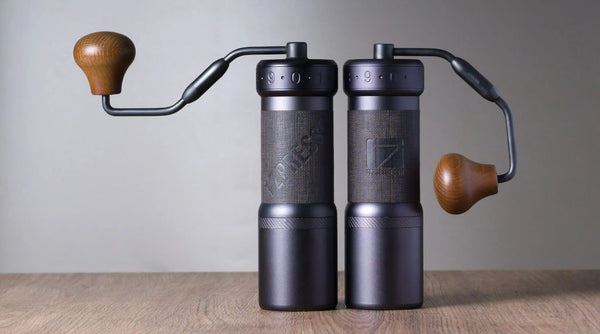

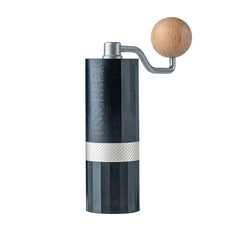
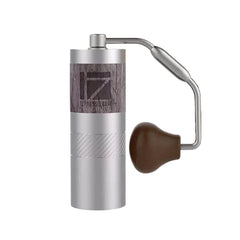


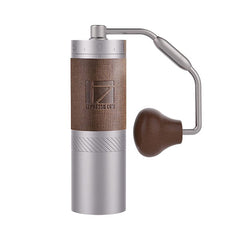

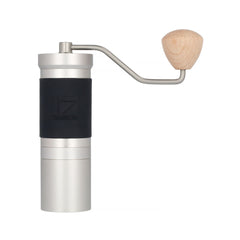
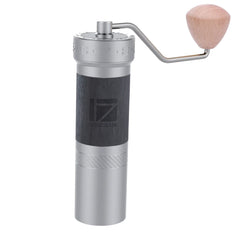
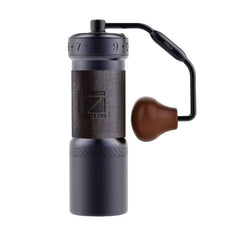


















 Alice is a writer, programmer and budding academic with a lifelong affinity for specialty coffee. Between sittings reading whatever text has caught her interest for the week or toying with a new game design project, she can be found fine tuning her home espresso setup or learning more about anything and everything to do with coffee.
Alice is a writer, programmer and budding academic with a lifelong affinity for specialty coffee. Between sittings reading whatever text has caught her interest for the week or toying with a new game design project, she can be found fine tuning her home espresso setup or learning more about anything and everything to do with coffee.

















